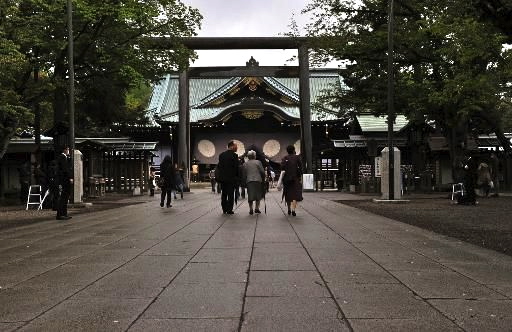Actions speak louder than words. While prime minister Abe was making a carefully coded statement to mark the 70th anniversary of the end of WW2, three of his cabinet ministers were allowed to visit Yasukuni JInja. Legitimising the shrine that stood at the heart of Japan’s military machine can be seen as part of an agenda to gradually restore elements of State Shinto, a movement which is backed by SAS (the political wing of the Association of Shrines).
The symbolic heart of this revisionist mission is Yasukuni and its glorification of Japan’s war dead, who are said to have sacrificed themselves for the sake of the emperor. Yet the emperor himself, known for his liberal sympathies, has refrained from ever visiting the shrine, for fear of encouraging the nationalistic right-wingers.
In contrast to the peace-loving animism preached by some Shinto theorists, Abe and his followers march to the beat of a narrow, nationalistic drumbeat. Their concerns are with patriotism, a greater role for the military, and expression of the national will. The struggle for the soul of Shinto has entered dark times indeed.

**********************
Three ministers visit Yasukuni
by Reiji Yoshida and Tomohiro Osaki Japan Times
On Saturday, Tomomi Inada, policy chief of the ruling Liberal Democratic Party, Haruko Arimura, minister in charge of female empowerment and gender equality, internal affairs minister Sanae Takaichi and disaster management minister Eriko Yamatani paid a visit to the war-linked Yasukuni Shrine in Tokyo’s Chiyoda Ward. Former Tokyo Gov. Shintaro Ishihara also visited the shrine and said he wanted the Emperor to also make a visit. Emperor Akihito has never visited the shrine.
Lawmaker visits to the Shinto landmark routinely draw condemnation from various quarters, particularly from China and South Korea, where wartime resentment against Japan lingers.
“I believe how we console the souls of people who died in the line of public duty is a matter of the people of each nation,” Takaichi told reporters at Yasukuni. “It is not something that should be treated as a diplomatic matter.”
Yasukuni is regarded by many countries as a symbol of Japan’s wartime militarism.
Prime Minister Shinzo Abe, who visited the shrine in December 2013, raising the ire of China, South Korea and the United States, did not visit the shrine Saturday.
Koichi Hagiuda, a Lower House member and close aide to Abe, visited the shrine Saturday morning. He told reporters at Yasukuni that Abe probably decided not to come because of the diplomatic tensions that were stoked by his last visit.
“(But) yesterday (Abe) told me his sense of gratefulness for the spirits (of the war dead) and his feelings for Yasukuni have not changed,” Hagiuda said, adding he made an offering to Yasukuni on behalf of Abe.
Abe has maintained his visit in 2013 was to pay his respects to all of the war dead, not to show reverence to war criminals.
Yasukuni Shrine honors 2.46 million people who “dedicated their lives to the state.” Most are soldiers killed in Japan’s modern wars, but also enshrined are 12 Class-A convicted war criminals of World War II, including wartime Prime Minister Gen. Hideki Tojo, together with two defendants who died while in detention.
***************
Click here for more on the political manipulation of Shinto and Yasukuni by the Abe regime.
